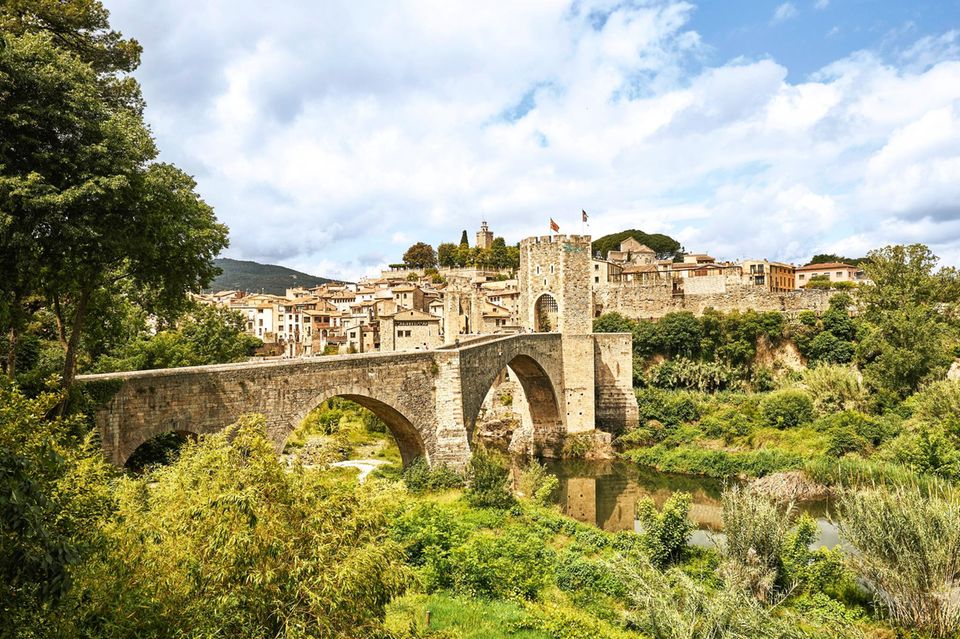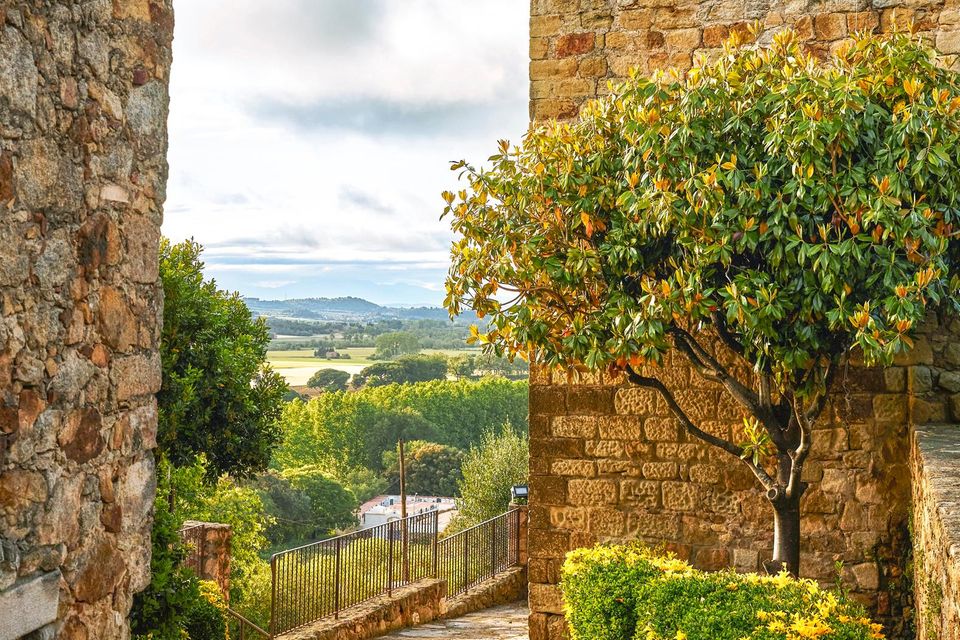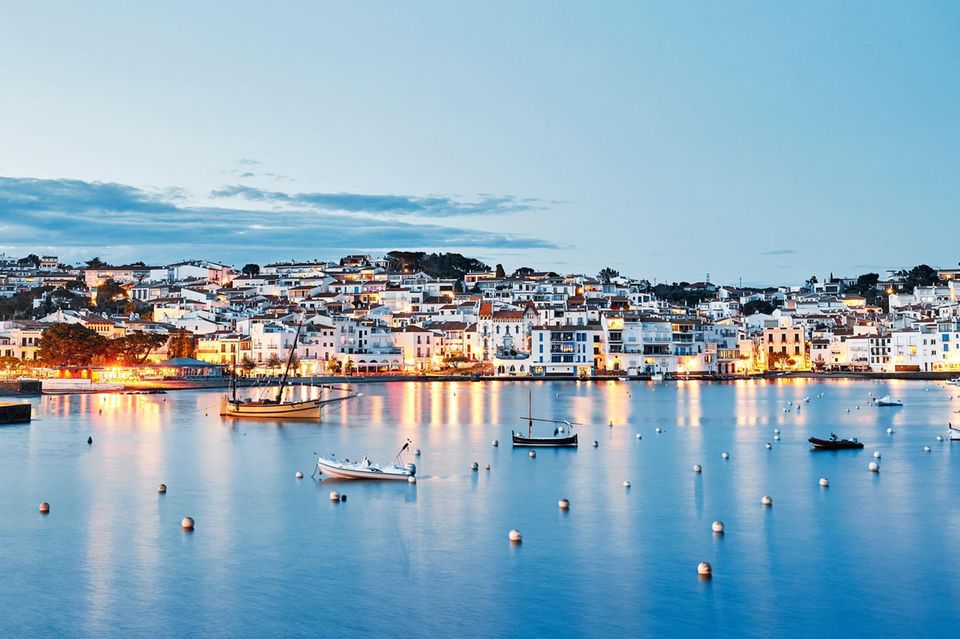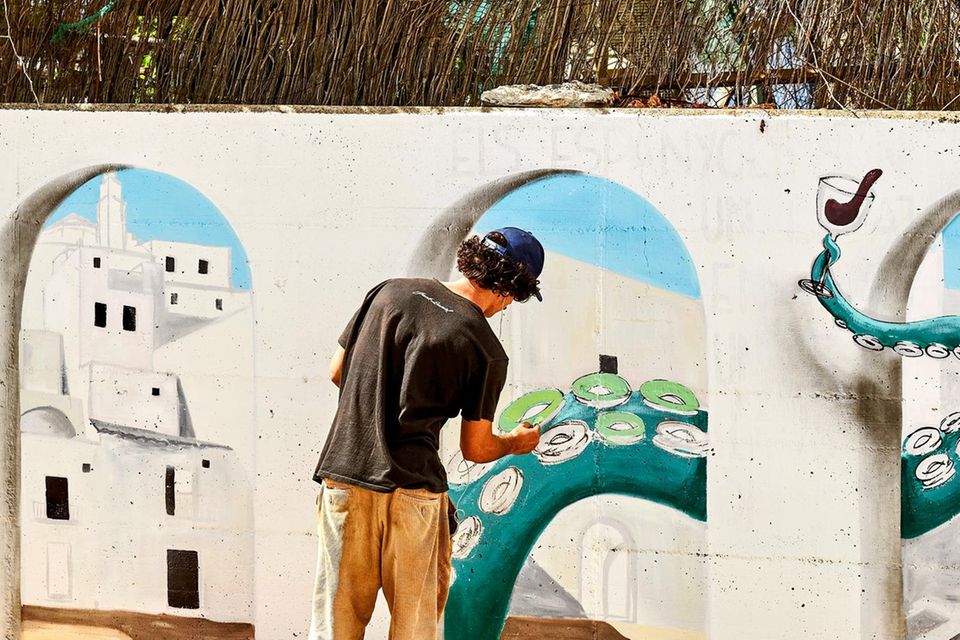Northern Spain: What makes Girona an insider tip in Northern Spain

by Nicole Schmidt
8 minsWild nature, crystal-clear water and enchanting cities: Despite its famous Costa Brava, northeastern Spain is still an insider tip – especially the charming Girona.
Half an hour ago, I was stressed out and throwing my suitcase into a corner of my hotel room in Girona. Now I'm sitting in a small café at the end of the Eiffel Bridge – and suddenly the switch has flipped. What a wonderfully relaxed atmosphere. All around me, cheerful guests chat as if they had all the time in the world. The airy bridge with its red steel mesh seems almost weightless in the light of the late afternoon sun. Over there, on the other bank, old, closely spaced houses glow in warm pastel colors. And the Onyar River reflects them as if painted, with gentle ripples.
Northern Spain: Good mood and wide views"This place is my first stop when I return home from one of my bike rides. Girona immediately puts me in a good mood ," says Alina Jäger, who's drinking coffee with oat milk next to me. It's a good thing I met up with her. Without her, I would have goose-stepped past this special place.
The Koblenz native has lived here, in the northeast of the Spanish province of Catalonia, for four years. She is a passionate cyclist and enthusiastically tells her 252,000 followers on Instagram about this city and her rides in the surrounding area and around the world.
We cross the bridge into the old town and stop in front of a bakery. "You absolutely have to try Schu-shu (spelled 'Xuixo'). I love this long pastry with the delicious Crema Catalana."

Are you looking for routines that help you unwind? Do you want to finally get a good night's sleep? Learn how to calmly handle stressful periods.
The medieval town of Besalú with its famous bridge over the river Fluvia.
© Christian Kerber / Brigitte
We stroll through a crazy labyrinth of narrow streets, the Jewish Quarter. Past pretty boutiques, her favorite bar, "La Garrina," on a secluded square under plane trees ("They make great organic wine themselves!"), up to the massive, 1,000-year-old cathedral. And many steps later, I enthusiastically walk along the medieval city walls. At every corner, new views of this beautiful old city, of cozy courtyards, manicured gardens, and wild islands of trees. And beyond, gentle green hills, the very first foothills of the Pyrenees. "From Girona, I can easily explore the surrounding area by bike," Alina enthuses. From here, you can quickly reach the coast, but also the mountainous hinterland.
That's exactly what I'm planning to do – but by car. North of Barcelona, the "wild coast," or Costa Brava, winds its way from Blanes for over 200 kilometers to Portbou, where it almost touches the French border. For me, the Costa Brava has been the essence of the Mediterranean ever since I first visited here many years ago: the light, the scent of pine trees in a small bay, crystal-clear water, a white village perched on jagged cliffs.
Delicacies in PalsPals, for example, is a 45-minute drive east of Girona. Removed from the world, the small village sits on a hill, surrounded by a gentle, rolling landscape of fields, olive groves, pine forests, cypresses, and farmsteads that remind me a bit of Tuscany.
The medieval village of Pals.
© Christian Kerber / Brigitte
Foreign cars and new buildings are not allowed in the old town center. Alleys, houses, squares, thick walls—everything is built of stone and immaculately restored. Geraniums sprout from amphorae in niches. Ivy and Virginia creeper climb around lattice windows and the church tower. A few locals and tourists savor the late spring sunshine with a glass of vermouth in the small market square. Instead of kitschy souvenirs, small shops sell ceramics, handmade jewelry, oil, and rice. Rice in Catalonia? Of course. Short-grain rice in eight varieties has been ripening in Girona's hinterland, the Empordà, for centuries.
"The Mediterranean climate, the slightly saline soil in the wetland, and the water of the Ter River give it a nutty flavor," explains Joan Carles Sanchez, who runs his restaurant "Es Portal" in a converted farmhouse just outside the town, over lunch. He cooks down-to-earth, regional dishes, fond of old recipes, but with a modern twist. "The days of foam, smoke, and all the frills are long gone for the chefs of the Costa Brava," he says, raving about the arroces, rice stews, "which are beautifully creamy here." My favorite is the rice pan with squid ink soffritto, sausages, coriander chicken, prawns, and mushrooms. It tastes of mountains and sea.
Dreamlike baysHalf an hour's drive later, in Begur, I get very close to the sea. I like the town, which stretches from the castle on the hill to the water's edge, almost better than Pals. It's by no means perfect. Cables hang from many of the walls, and the architectural blemishes from the 1970s are impossible to miss. But that's precisely what makes the place lively and colorful. Small shops, galleries, and boutiques invite you to browse. And among the old, simple houses, I keep noticing magnificent villas in bold colors, with columns at the doorways, stucco on the windows, and palm trees in the garden. These are the "Casas de los Indianos," built by wealthy returnees from Puerto Rico and Cuba at the end of the 19th century.
"You have to see the coves around Begur. They're the most beautiful on the Costa Brava," Alina had told me. I booked a room in a friendly, newly renovated hostel in one of these coves: Cala Sa Riera. It's quite spacious, with golden sand, rocks on both sides, and beautiful water. Equally beautiful are the coves of Calella de Palafrugell and the even smaller and quieter Tamariu. Two old, meticulously maintained fishing villages with lovely arcades and boats moored on the beach.
From my hostel, I walk part of the way along the "Camí de Ronda," an ancient, well-developed hiking trail. It mostly leads me along the steep coast, occasionally crossing wooden walkways, stairs, small bridges, and past the country road. In some places, it's just a dirt path. Agaves, prickly pears, and pines cling to rugged red cliffs. Waves lap at bizarre boulders. Seagulls screech. The air smells of rosemary and lavender. I climb over a high cliff, enjoying the peace and quiet. And then I spot it: the bay of Sa Tuna . Embraced by rocks, the water shimmers a green-blue, a few houses nestled between pine trees on the slopes. It lies there dreamily, at least for now, without any summer guests. What luck!
The next morning, I leave the sea and drive an hour north, deep into the vast Empordà landscape. The Pyrenees are drawing closer. Chamomile blossoms, broom, and purple thistles decorate the roadside, and behind them, vineyards stretch as far as the eye can see. I hadn't expected that either, so close to the coast. "The Tramuntana wind often blows here; it's very hot in summer, so the plants have to fight hard. That makes them strong. And our Cava especially," explains Ingrid Teixidor, the manager of "Bodega Oliveda" in the wine-growing village of Capmany, where I take a break. I buy three bottles of her finely effervescent sparkling wine.
Favorite place CadaquésBarely more than an hour's drive later, I'm walking through the heart of a volcano that's been dormant for 11,500 years. The Croscat, along with dozens of older, forest-covered brothers and solidified lava flows, forms the La Garrotxa Natural Park. It was once a quarry until it was placed under protection. Its rock layers lie open and shimmering, in all shades of red and brown. And that's the steely blue sky. Wow.
92 kilometers further east lies Dalí's favorite place, "Cadaqués," a whitewashed fishing village by the sea, hidden on the wild Cap de Creus peninsula. With its enigmatic, magical, and timeless flair, it also enchanted Picasso and many other creative minds in the 1930s.
Evening atmosphere in the bay of Cadaqués.
© Christian Kerber / Brigitte
The pass road over the steep Serra de Rodes is winding and somewhat bumpy. Suddenly, the view opens up to the crescent-shaped bay. Whitewashed houses stand around them. The bumpy slate streets. The casino, a mix of community center, club pub, and bar, in a prime location on the market square, where old men play cards. The fish restaurants with old-fashioned awnings. The sky-blue bicycle on the wall, where a pink bougainvillea climbs. No high-end boutique. No lifestyle bar. Just a few casual boho shops. And how long has that yellowed Dalí photo with a painted beard been stuck to the woodworm-ridden door?
Street artist in Cadaqués.
© Christian Kerber / Brigitte
I sit on the quayside, gaze out at the sea, and feel completely removed from this world. Sure, I think, it's no longer Dalí's Cadaqués. But it carefully cultivates its unique charm and remains true to itself. Costa Brava, you've won me over again!
Our tips for Girona Getting there & aroundFly with Ryanair from Frankfurt-Hahn or Düsseldorf-Weeze to Girona (from €100). Alternatively, fly to Barcelona, which is served by many airlines (e.g., Lufthansa from €153). From there, continue by rental car (1.5 hours to Girona). This is also the best option if you want to explore the area.
Stay overnightHostal Ses Negres. Wake up and jump into the sea! This nautical-style hostel with 17 rooms and four apartments in one of Begur's enchanting bays makes it possible. Double room with breakfast from €90 (Begur-Sa Riera, C/del Mar, 8, Tel. +49 649 71 51 71, hostalsesnegres.com).
Hotel Nord 1901. This pleasant boutique hotel with a garden and pool is ideally located in a side street of the old town. It was built as a home by the grandfather of the owner family in 1901. Double room with breakfast from €139 (Girona, C/del Nord 7-9, Tel. +49 972/41 15 22, nord1901.com).
Villa Salvador. Like a summer house nestled among olive groves with the scent of the sea at your doorstep, it boasts a modern and elegant design, white and sandy tones, a long saltwater pool, and a good restaurant: This new boutique hotel in Cadaqués is a real success. Double room with breakfast from €257 (Camí des s'Arenella, 3, Tel. +49 872/20 82 62, hotelvillasalvador.com).
EnjoyCasa Juanita. This rustic restaurant, located in one of Begur's old town houses, has been welcoming guests for almost 50 years. Lamb or rock fish dishes cooked with onions, tomatoes, garlic, white wine, and olive oil (€25–28) emerge from the open oak wood oven. Melts in your mouth. (Begur, C/. Pi i Ralló, 7, Tel. 072/62 20 13, casajuanita.cat).
Es Portal. Joan Carles Sanchez's favorite dish is his arroces, traditional rice stews with a modern twist, for example, with grilled octopus, duck confit, and smoked mayonnaise (€25), almost all of which are locally sourced. His restaurant is a perfect match: a glass extension to a 500-year-old farmhouse near Pals in the countryside (Pals, Crta. de Pals a Torroella de Montgrí, 17, esportalhotel.com).
La Garrina. My wine bar tip for twilight in Girona. The guests are so relaxed and cheerful, the square in the heart of the old town is so pretty, and the natural wines, guacamole, and wok-fried Pad Thai (€12) are so good. (C/. de Bonaventura y Peralta, 11, Tel. 06 48/19 94 43, soloelamorsalvaraelm.wixsite.com/lagarrina)
ShoppingGirona. Small specialty shops instead of large chains, local designers, a relaxed atmosphere, and all this in a pretty old town: you just have to grab a bargain! For example, here: Lavanda, essential oils, scented pillows, candles made from natural raw materials (C/. de les Ballesteries, 34); Vimet, regional products (C/. de les Ballesteries, 2, @vimetgirona); Duransisters, romantic floral designer fashion (C/. Cort Reial, 3, duransisters.es). The main shopping street is the Rambla de la Llibertat.
ExperienceCamí de Ronda . Proof: The Costa Brava can also be pristine and secluded. This hiking trail winds its way through the hinterland and along the coast along ancient connecting paths. It's 140 kilometers round trip, or a spectacular 43 kilometers from Sant Feliu de Guíxols to Begur; partial routes are also possible. Well-maintained, marked in red and white, packages including overnight stays and luggage transfers can be booked on the website (camideronda.com).
Fish auction. Watch live as crates of prawns, sardines, monkfish, and squid roll down the conveyor belt in the fish auction hall at Palamós harbor, with prices dropping by the second until a dealer strikes at the push of a button. Guided tour only, admission €3.50 (Palamós, Museum and Espai de Peix, Moll pesquer, s/n, Tel. +49 972/60 04 24, museudelapesca.org).
phoneThe area code for Spain is 00 34
The Cal Sastre is a quiet eight-room hotel in medieval Santa Pau, featuring quarry stone walls, wooden ceiling beams, and antique family heirlooms. The attached restaurant serves authentic Catalan cuisine. Double rooms from €140 (Plaça dels Valls, 6-9, calsastre.com)
The name says it all: At the restaurant "Compartir" in Cadaqués, they offer sharing dishes, so you can sample many of the delicacies. Make a reservation! (compartircadaques.com)
TravelThere are lanky elephants in the garden of the "Castell Gala Dalí" in Pubol. The artist Salvador Dalí transformed the castle into a surreal fairytale palace (salvador-dali.org/en/museums)
For more information visit costabrava.org
If I had known that…In July and August, the whole of Spain is on vacation, and the Costa Brava is also packed. In May/June and September/October, unlike many other regions of Spain, it's much quieter. And you can swim right into November!
Brigitte
brigitte









